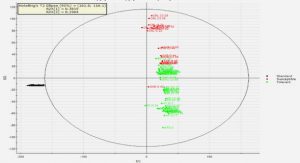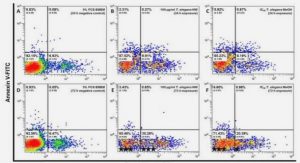Get Complete Project Material File(s) Now! »
Mathematical Discourses
In this study, I used the notion of discourse as defined by Gee (2005). Gee makes a distinction between the terms discourse with a lower case “d” and with a capital “D”. He refers to discourse as the language refers to discourse as the language–inin–use or the use of language “on site” (use or the use of language “on site” (Gee, 2005:Gee, 2005: 7)7),, and to Discourse as language pluand to Discourse as language plus “other nons “other non–language stuff” and thus states that language stuff” and thus states that Discourse is:Discourse is:
ways of combining and integrating language, actions, interactions, ways of ways of combining and integrating language, actions, interactions, ways of thinking, believing, valuing, and using various symbols, tools, and objects to thinking, believing, valuing, and using various symbols, tools, and objects to enact a particular sort of socially reenact a particular sort of socially recogncognisisable identity (these are social practices) able identity (these are social practices) ((Gee, Gee, 20052005: : 21).21).
This suggests that the meanings derived in any one Discourse situation are multiple, the meanings derived in any one Discourse situation are multiple, varied and situated in context of use. For examplevaried and situated in context of use. For example,, “un cuarto” in Spanish means “a “un cuarto” in Spanish means “a room” or “a fourth”room” or “a fourth”,, depending on the context of use (Khisty, 1995, in Moschkovich,depending on the context of use (Khisty, 1995, in Moschkovich, 20022002:: 194194). In this case, as a Spanish student moves from informal to formal ). In this case, as a Spanish student moves from informal to formal mathematics language, he/she needs to tease out the intended meaning of “un cuarto” mathematics language, he/she needs to tease out the intended meaning of “un cuarto” within a specific mathematics Diwithin a specific mathematics Discourse.scourse.
Moving from informal mathematics language to formal mathematics language means that students are involved in learning standard terminologies or the mathematics register. that students are involved in learning standard terminologies or the mathematics register. The knowledge of The knowledge of the the mathematics register facilitates mathematical conversatimathematics register facilitates mathematical conversations in the ons in the classroom (Pimm, 1987). In order for students to acquire this register, it is imperative classroom (Pimm, 1987). In order for students to acquire this register, it is imperative that teachers teach from the basis of that teachers teach from the basis of a a conceptual curriculumconceptual curriculum9 so that students come to so that students come to learn and understand the intended curriculumlearn and understand the intended curriculum (Thompson & Thompson, 1(Thompson & Thompson, 1994)994)..
In a a conceptual curriculum the teacher provides and asks students for explanations in the conceptual curriculum the teacher provides and asks students for explanations in the process of solving a task process of solving a task (Thompson & Thompson, 1994)(Thompson & Thompson, 1994). Alongside the conceptual . Alongside the conceptual orientation is the calculational orientation, which is viewed as composed of proorientation is the calculational orientation, which is viewed as composed of procedural cedural steps of mathematical operations. The distinction between these two classroom steps of mathematical operations. The distinction between these two classroom orientations has been extended into calculational and conceptual discourses byorientations has been extended into calculational and conceptual discourses by Sfard, Sfard, Nesher, Sreefland, Cobb Nesher, Sreefland, Cobb andand Mason (1998)Mason (1998). These authors refer to calculational . These authors refer to calculational 9 Conceptual curriculum is the curriculum in which teachers are Conceptual curriculum is the curriculum in which teachers are sensitive to learners‟ thinking during instruction and shape their instructional actions accordingly in order to ensure that learners attain the intended concepts (Thompson & Thompson, (Thompson & Thompson, 1994)1994). discourses as thurses as thosose discussions in which the primary topic of conversation is based on e discussions in which the primary topic of conversation is based on any type of calculational process. The conversation involves describing the specific any type of calculational process. The conversation involves describing the specific steps that have been followed steps that have been followed inin arrivarrivinging at a mathematical solution. However, this can at a mathematical solution. However, this can bbe contrasted with a conceptual discourse in which the reasons for calculating in e contrasted with a conceptual discourse in which the reasons for calculating in particular ways become explicit topics of conversation. In the latter case, conversations particular ways become explicit topics of conversation. In the latter case, conversations encompass both students’ calculational processes and the encompass both students‟ calculational processes and the interpretationinterpretations of thes of the taskstasks that that underlie the ways of calculating. underlie the ways of calculating.
Integrating the calculational and conceptual discourses at play with Discourse ((GeeGee,, 2005), it 2005), it waswas relevantrelevant to to this study to ask what Discourses accompany the conceptual this study to ask what Discourses accompany the conceptual and calculational discoursesand calculational discourses10 as trilingual sas trilingual students respond to a mathematics task. In tudents respond to a mathematics task. In other words, when students explain their mathematical understanding conceptually other words, when students explain their mathematical understanding conceptually and/or calculationally, in what ways do they integrate and combine language and “nonand/or calculationally, in what ways do they integrate and combine language and “non–language stuff” to communicate this understandinlanguage stuff” to communicate this understanding? The notion of Discoursesg? The notion of Discourses and hence and hence mathematical Discoursesmathematical Discourses is discussed in greater detail in Chapter 4.
Language diversity and mathematics education: a focus on bilingual contexts Research in mathematics education and language diversity can be traced back to studies on bilingualism and bilin gual learner s . Some early studies in this area show that bilingualism may have negative effects on bilingual learners and may be the cause of cognitive confusion and retardation in learners (e.g. Downing, 1974; Macnamara, 1967 ; Saer, 1923) 1923). Other related s tudies challenge d this view and show n that bilingualism is an asset that provides support for both cognitive and linguistic development see, Peal & Lambert, 1962, in Carringer, 1974) 1974). More recent works suggest that there is developmental interdependence b etween the languages of a bilingual that could be of benefit to him/her (Cummins, 1979). Research in mathematics education has used this otion to show that competence in the two languages influences a bilingual learner s mathematical performance (see e. Dawe, 1983) 1983). Further research has explored bilingual learners’ mathematics performance when tasks are presented in their two languages (see e.g. Zepp, 1982). It is worth noting that research in mathematics education in multilingual contexts has support ed the notion that learners’ h ome language s are resources for learning and teaching mathematics as they increase in proficiency in the LoLT, which in most cases is not their h ome language (see e.g. Adler, 1997: 1998; 1998; Setati, 1998). These studies areSetati, 1998). These studies are,, howeverhowever,, more recent than those involving more recent than those involving bilingual learners.bilingual learners. How the How the hhome languageome languages are used in multilingual contexts are used in multilingual contextss is is discussed in the Chapter 3discussed in the Chapter 3, section 3.2 & 3.3, section 3.2 & 3.3. .
In the next sectionthe next section,, studiesstudies on bilingualism and learningon bilingualism and learning are reviewed, as well asare reviewed, as well as the the influeninfluence of bilingual learners’ language(s) competence on ce of bilingual learners‟ language(s) competence on their their mathematics mathematics performance, and laterperformance, and later onon mathematics performance when tasks are presented in two mathematics performance when tasks are presented in two languages. languages.
Research in bilingualism and learning: from detrimental to positive effects
The question of the potential effect of bilingualism on learners’ language, cognitive and ion of the potential effect of bilingualism on learners‟ language, cognitive and educational development has long been educational development has long been of interest toof interest to researchers. Early research in this researchers. Early research in this area tended to focus on the challenges that bilingual learners faced area tended to focus on the challenges that bilingual learners faced when comparedwhen compared to to their monolingual peers. For example, Saer (1923)their monolingual peers. For example, Saer (1923),, working with Welshworking with Welsh–English English bilingual learners aged between bilingual learners aged between 77 and and 1212 years, years, showshoweded that the learners performed that the learners performed poorly on verbal parts of intelligence tests, relpoorly on verbal parts of intelligence tests, relyingying more on memory more on memory inin their two their two languages thalanguages than on reasoning. Furthermore, the different languages in their repertoire n on reasoning.
Furthermore, the different languages in their repertoire were found to were found to causecause mental confusionmental confusion. In his work, Macnamara (1967) observed that . In his work, Macnamara (1967) observed that bilingual students were slower than their monolingual peers in responding to arithmetic bilingual students were slower than their monolingual peers in responding to arithmetic problems. problems. HeHe studied the effects of instruction in a weaker language among sixthstudied the effects of instruction in a weaker language among sixth formform EnglishEnglish–Welsh bilinguals. The weaker language in this case was the second language. Welsh bilinguals. The weaker language in this case was the second language. Macnamara Macnamara observedobserved that although bilingual students translated words and expressions that although bilingual students translated words and expressions intointo their sectheir second language, the translation did not necessarily help theond language, the translation did not necessarily help themm to decode the to decode the actual meaning. Thus Macnamara concluded that using such languages to teach students actual meaning. Thus Macnamara concluded that using such languages to teach students could result in retardation in subject matter could result in retardation in subject matter knowledgeknowledge. These studies . These studies suggestedsuggested that that bilingualisbilingualism m could havecould have detrimental effects on studentsdetrimental effects on students’’ intellectual functioning.intellectual functioning.
CHAPTER 1 . SETTING THE SCENE
1.1 Introduction .
1.2 Problematising trilingualism in mathematics education
1.3 Purpose of the study and research questions.
1.4 Theoretical orientation
1.5 Rationale for this study
1.6 Conclusion
CHAPTER 2 LANGUAGE, MATHEMATICS AND PERFORMANCE: INSIGHTS INTO THEORY AND PRACTICE
2.1 Introduction
2.2 Language and mathematics
2.3 Language diversity and mathematics education: a focus on bilingual contexts
2.4 Conclusion
CHAPTER 3 LANGUAGE PRACTICES OF BILINGUAL AND MULTILINGUAL MATHEMATICS STUDENTS
3.1 Introduction
3.2 Language practices of multilingual students
3.3 Code switching
3.4 How trilingual students use their three languages
CHAPTER 4 THEORETICAL FRAMEWORK FOR EXPLORING LANGUAGE PRACTICES OF TRILINGUAL STUDENTS
4.1 Introduction .
4.2 Why the choice of Discourse analysis?
4.3 Discourse Analysis
4.4 Method of Discourse analysis .
4.5 Conclusion
CHAPTER 5 RESEARCH DESIGN AND METHODOLOGY
CHAPTER 6 DATA ANALYSIS
CHAPTER 7 LANGUAGE PRACTICES INVOLVING ENGLISH ONLY
CHAPTER 8 LANGUAGE PRACTICES INVOLVING TWO LANGUAGES
CHAPTER 9 LANGUAGE PRACTICES INVOLVING THREE LANGUAGES
CHAPTER 10 SUMMARY OF FINDINGS, RECOMMENDATIONS AND CONCLUSION
REFERENCES






